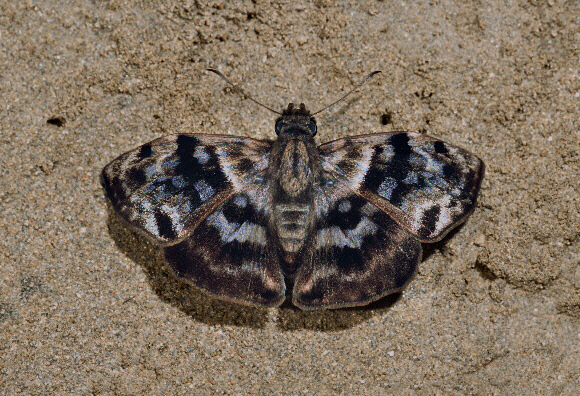
Introduction
The Pyrginae, popularly known as Flats or Spreadwings, are a cosmopolitan subfamily distributed across temperate and tropical habitats throughout the world. In the Americas there are 990 species.
There are 7 species in the genus Ebrietas, which is closely allied to Camptopleura, Cycloglypha and Gorgythion. Members of these genera are characterised by their small size ( circa 3cms wingspan ), large heads, and by the way in which they bask with their marbled brown wings folded downwards halfway along the costa.
In common with a great many other Pyrgine skippers, Ebrietas anacreon is a butterfly that looks dull and uninteresting from a distance, but when seen closely is a creature of great beauty, with wings reflecting subtle shades of blue or purple when the sunlight catches them at the right angle.
This butterfly occurs in Costa Rica, Panama, Colombia, Venezuela, Guyana, Surinam, Brazil, Ecuador, Peru and Bolivia.
Habitats
This is a lowland rainforest species found commonly at altitudes between sea level and about 800m.
Lifecycle
Unknown. Generally however, Pyrgine butterflies lay their eggs singly on the leaves of low growing herbaceous plants or bushes. The larvae are typically dull green or brownish, with thin longitudinal lines along the back and sides, and with black shiny heads. The pupae are usually dark and smooth, with the wing cases in a contrasting tone or colour. They are normally formed within silken tents formed by spinning together the leaves of the foodplant.
Adult behaviour
Males are usually seen singly or in two’s or three’s when imbibing moisture from sandbanks, sunlit paths or road surfaces. At such times they tend to flit about over a small patch of ground until they find a suitable feeding spot, after which they wall about probing the ground with the proboscis. If undisturbed they will remain at their chosen feeding spot for several minutes.
Both sexes can also be found flying around bushes and shrubs in forest edge habitats, with males occupying territorial perches on the terminal leaves of small bushes.
